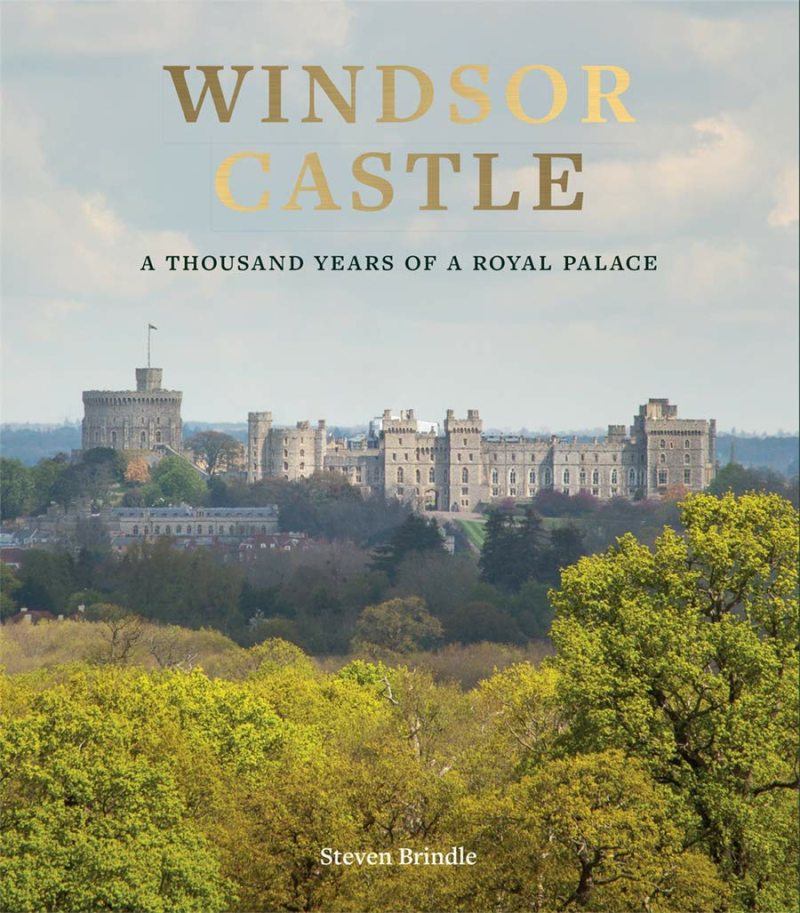Windsor Castle: a thousand years of a royal palace
Windsor Castle: a thousand years of a royal palace, Edited by Steven Brindle, with contributions from Steven Brindle, Eleanor Hoare, Brian Kerr, Charlotte Manley, Jonathan Marsden, Clare Rider, Jane Roberts, Nigel Saul, Tim Tatton- Brown, Simon Thurley and Michael Turner, Royal Collection Trust, 2018, 552 pages, 89 black and white and 279 colour illustrations, 38 plans and maps.
Catastrophes can bring out the best in people. The adage certainly applies to the devastating fire at Windsor Castle during the Queen’s annus horribilis of 1992 that triggered both the common effort to restore the destroyed state apartments and the comprehensive, archaeologically supported reassessment of the castle’s past. Written by authorities on the castle’s fabric and contents, this monumental account delivers the first holistic view of Windsor Castle’s history for generations and sets historiographic standards for years to come.
The subtitle should not be taken too literally. Apparently, the earliest known structure on site, a motte and bailey with timber palisades, was built after 1066 as a defensive fortress. The first court recorded here was held by Henry I in 1110 when the new masonry-built King’s Hall and King’s Houses on the hill replaced Old Windsor down the Thames. It was only around 1240 under Henry III, a decade after the completion of the castle’s defences, that Windsor Castle effectively became the Crown’s principal residence outside London. We learn that the kings had been tenants – curiously, the Crown did not buy the manor until 1546. Windsor Castle may not be a millenarian such as Castel Sant’Angelo or the Palace of Goslar, but it outshines any castle or palace worldwide as both the doyen and the largest of continuously occupied royal residences.
In its modern-day appearance (Jeffry Wyatville’s rebuilding from 1824 to 1840) the castle has become the very emblem of princely abode, imitated from Stolzenfels to Babelsberg. Like the Vatican City, it functions as a living community, inspired by tradition, and held together by the sovereign. Kings and queens from the Plantagenet to our own Elizabethan era have left their mark as the various incarnations of royal lodgings mirror all phases of architecture, whether Edward III’s Romanesque or George IV’s Tudor-gothic style. The state rooms have been adorned by eminent artists and craftsmen such as Antonio Verrio and Grinling Gibbons. Windsor Castle serves as a three-dimensional panorama of English architectural and art history – and so does the book.
The authors recount the complex story of this 910-year-old royal palace in tandem with an abundance of written sources, accompanied by conjectural reconstructions and a plethora of exquisite illustrations. These include superb etchings by Wenceslaus Hollar; gorgeous aquarelles prepared for WH Pyne; hand-coloured lithographs by John Nash; and the most delicious photographs of St George’s Chapel’s interior. Every aspect, every element enjoys full representation – upstairs and downstairs: the accumulated labyrinth of state apartments and the warren of kitchens; the distinctive cloisters of the College of St George; the chain of walls and towers; as well as Windsor Great and Little Park with Victoria and Albert’s resting place at Frogmore.
‘Windsor Castle’ is a beautifully written and sublimely illustrated tome that reflects the magnificence of its subject on every page. Meticulously researched, it contains 28 pages of annotations and 30 pages of bibliography. Enclosed are colour-coded floor plans, dating the fabric in the upper, middle and lower wards. At 552 pages, reading this masterpiece makes for an apt pastime in our new age of self-isolation. Today, more than ever, one’s home is one’s castle.
This article originally appeared as ‘One’s home is one’s castle’ in Context 167, published by the Institute of Historic Building Conservation (IHBC) in March 2021. It was written by Michael Asselmeyer, historian and architect.
--Institute of Historic Building Conservation
Related articles on Designing Buildings Wiki
IHBC NewsBlog
Old Sarum fire in listed (& disputed) WW1 Hangar - Wiltshire Council has sought legal advice after fire engulfed a listed First World War hangar that was embroiled in a lengthy planning dispute.
UK Antarctic Heritage Trust launches ‘Virtual Visit’ website area
The Trust calls on people to 'Immerse yourself in our heritage – Making Antarctica Accessible'
Southend Council pledge to force Kursaal owners to maintain building
The Council has pledged to use ‘every tool in the toolbox’ if urgent repairs are not carried out.
HE’s Research Magazine publishes a major study of the heritage of England’s suburbs
The article traces the long evolution of an internal programme to research 200 years of suburban growth
IHBC Context 183 Wellbeing and Heritage published
The issue explores issues at the intersection of heritage and wellbeing.
SAVE celebrates 50 years of campaigning 1975-2025
SAVE Britain’s Heritage has announced events across the country to celebrate bringing new life to remarkable buildings.
IHBC Annual School 2025 - Shrewsbury 12-14 June
Themed Heritage in Context – Value: Plan: Change, join in-person or online.
200th Anniversary Celebration of the Modern Railway Planned
The Stockton & Darlington Railway opened on September 27, 1825.
Competence Framework Launched for Sustainability in the Built Environment
The Construction Industry Council (CIC) and the Edge have jointly published the framework.
Historic England Launches Wellbeing Strategy for Heritage
Whether through visiting, volunteering, learning or creative practice, engaging with heritage can strengthen confidence, resilience, hope and social connections.















